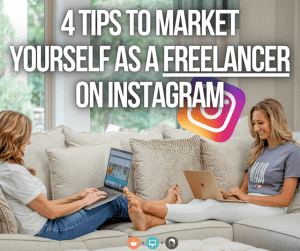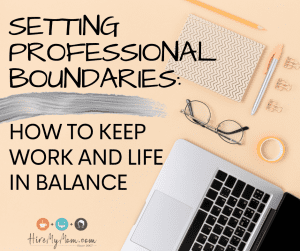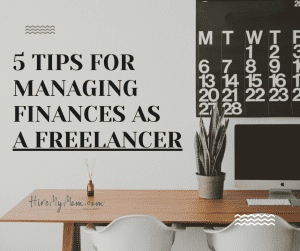Let me be one of the first ones to congratulate you on your decision to pursue your passions and share your God-given gifts with the world as a freelancer. While it’s not an easy journey, I can speak from over 20 years of experience that it’s a very rewarding one.
One of the biggest hurdles to get over in this industry isn’t how to create a website, brand yourself or master social media but in landing your first paying client in what feels like a very crowded and competitive marketplace. However, with a well planned strategy, an attitude of determination and believing in what God has called you to do, I think you will find landing your first client can be easier than you think.
Here are 10 strategies to help you land your first client as a freelancer.
- REACH OUT TO FRIENDS AND FAMILY
While this strategy will not work for the long term because let’s be honest, while most of your friends and family will whole-heartedly support your business and cheer you on, the majority of them are not going to be your target market or ideal client but that doesn’t mean you can’t share with them what you are doing.
Maybe you just launched a graphic design business, for example. Let your friends and family know what you are doing and what kind of client you are looking to work with. You can shoot them a quick message on Facebook or an email.
Here is a sample script you can use to get you started:
“Hi Sally! Hope you and the kids are doing well. I have loved seeing your vacation photos on Facebook recently looks like a really fun time! I wanted to send you a quick message to let you know I just started my own graphic design business. I create logos for small women business owners (attached is an example design). I know you may not be in the immediate need for a graphic designer but if you hear of anyone looking for one I would greatly appreciate you referring them my way. I would also be grateful your prayers and support as I embark on this new journey as a freelancer and of course let me know if there is anything I can do to support you too!”
When reaching out to people, it’s important not to be pushy or demanding. Make your messages personable, don’t send out copy and paste messages as they can feel cold and pretty easy to spot. The goal is to help spread the word about what you do in a non-salesy way and through these messages you may find 1-2 people through your warm market who are actually in need of the services you provide or can quickly refer you to someone who does.
- ETSY/CREATIVE MARKET
As a freelancer you can create an account, online shop and list your products and services on sites like Etsy and Creative Market. Staying with the same example as a graphic designer, you could list logo examples available for purchase. Ensure your listings are optimized by thinking about how your ideal client would be looking for your service or product. It’s important to research the fees associated with these websites as while they can help you land a new client quickly they do take a percentage of the sale.
- CREATE A WEBSITE
As a freelancer, it’s important to start branding yourself as a professional and a website is crucial to that strategy. A website allows your first client to find you easier online through Google searches and showcase your experience, skills and expertise.
As you reach out to people to share your services you will find most will ask “What is your website?” because in the information driven age we live in, people want to see it and read it for themselves. It’s also not a good use of your time to keep explaining to people over and over what you do when you can direct them to a website where you have shared everything they need to know all in one place and can check out examples of your work through a portfolio.
Through blog posts you can give free value and solve problems to help you gain the trust of your next client who desperately needs what you have to offer. Create a blog board on Pinterest to showcase your blog posts in one place.
- NETWORK LIKE CRAZY
There is no sugar coating that landing your first client will take some old fashioned hustle. Go to local networking meetings where you can build relationships faster face to face. Go prepared with a warm smile and a stack of well designed business cards and don’t make the business killing mistake of handing your business card to someone and not asking for theirs in return. Not only does this come across as self-serving but you need to go home with a stack of contacts that you can connect with on social media to keep building the relationship with.
You can find local networking groups through Meet Up, Facebook and by searching your local Chamber of Commerce for events such as luncheons and mixers happening in your area.
- CREATE A FACEBOOK BUSINESS PAGE
You will find that social media will play a huge role in your business and landing your first client. There are many advantages to having a Facebook Business Page like having the content indexed by Google and having the ability to run Facebook ads to target your ideal client.
You can use your page to go live and give valuable tips to your audience that will help you stand out as an expert and build relationships with your audience while sharing calls to actions that direct your audience to what you offer.
- UPDATE YOUR LINKEDIN PROFILE
Just like a Facebook business page, LinkedIn is indexed by Google and can help your ideal client find you. Maybe your profile is old and outdated? Now is the perfect time to update your profile photo, cover photo, title, skills sets, work history, etc. You can even publish some of your blog posts to your profile to give value and showcase your expertise.
If you don’t have a LinkedIn profile, definitely create one and start putting it to work for you as a freelancer.
- DON’T WORK FOR FREE
As a new freelancer, you need experience and testimonials to keep new clients coming in. And while it may be tempting to offer your services for free in order to build a portfolio and client feedback, I can assure you this is not a route you want to take.
Doing free work can chip away at your confidence and self worth and believe me, not even the people closest to you will respect your time or talents if you offer to do them for free and by doing so you are just opening up a can of worms. Let’s say you create a free logo for your dear Aunt Sally who then tells another member of your family that you created a beautiful logo for her for free and “probably wouldn’t mind” doing it for them too.
Hear me on this, value what you do and don’t discount your worth. If you want to have a goal of getting 5 testimonials for your website or Etsy shop as quickly as possible because you know it will help you get even more clients, great but do not work for free.
You will find especially if you are a service-based business that people, usually under no ill intentions, will come to you and say “I just need you to do this one thing, take a look at this one website, I just need 15 minutes of your time” so it’s best if you learn early on how to deal with this. None of us get to the privilege to walk into a doctor’s office and say “I just need 15 minutes of the doctor’s time to look at this spot on my arm” so don’t allow anyone to steal time from you either.
Tell Aunt Sally that you are willing to create a simple logo for her this one time at a discounted rate in exchange for a testimonial and give her a one time coupon code with an expiration date to create urgency to use on your website or in your shop but decide now not to work for free.
- COLLABORATION
There are lots of business owners out there who are working with clients using their skills sets but need to hand off work that they either are not qualified to do or don’t want to do. For example, a person that designs websites very often has clients that need a logo, branding advice, copywriting services, graphic design work for other elements, photography, etc. The web designer needs to be able to refer their clients to someone who can take care of these tasks. By collaborating with other business owners you can create an endless network of referrals.
Think about people in your field who would need to have you as a referral and reach out to them to let them know you would love to collaborate and also send client referrals their way too.
- COLD CALLING / EMAILING
Okay, I know just the sound of that may have made you cringe but hear me out. As a freelancer, especially a starting out one you will need to break out of your comfort zone a bit but that doesn’t mean you have to be sleazy or obnoxious either.
The beauty of the online marketplace is the ability to generate leads while you sit at home in your yoga pants, coffee in hand and your laptop (I know all you introverts are saying “AMEN!” right now). There are millions of leads out there, you just have to be willing to go find them.
If you are a virtual assistant, you can research small online business owners through social media or googling a few keywords of your ideal client like “Christian coach” and find lots of websites. This allows you to seek out who you want to work with and sending them a message either through email, LinkedIn, Facebook fan page messenger, etc.
Yes, there will be people you never hear back from and yes there will be people who respond and say they aren’t looking for your services right now but so what. You never know when those seeds you planted in faith will come back to you.
Here is a sample script you can use when reaching out to potential clients you find online:
“Hey Becky, my name is _________ and I am a freelance virtual assistant who came across your website. I love the passion you have for your calling and have no doubt the clients who work with you are very blessed to have your guidance. I read one of your blog posts __________ and it was so moving and inspiring.
The reason I write to you today is to introduce myself and to inquire if you are in need of a virtual assistant at the moment? My skills sets include __________ and you can visit my website to see my portfolio and testimonials www.________.com
Whether you are in need of my services at the moment or not, I am grateful for the connection and appreciate you taking the time to read this email. I have also connected with you on your Facebook page and sent a connection request via LinkedIn so I can continue to support you in the work you are doing.
Thank you again for your time and consideration,”
The goal is to make a connection and build a relationship but can you imagine the leads you would generate if you sent just 5 emails per day to people you found online and wanted to work with!? Yes this takes work, time and a lot of consistency to keep showing up when your inbox goes empty, but I can promise you God will work to nurture these seeds if you will be brave enough to plant them in faith.
- HIRE MY MOM COMMUNITY
Did you know for the past 12 years HireMyMom has been helping freelancing women and moms just like you find quality, legitimate work from home jobs and clients? By joining our community, you can confidently share your skills and look for high quality positions and clients as well as have access to more training and resources to help you build your business. Click HERE to learn more about what we have to offer and become a member today.
Were these tips helpful? Connect with me on social media on LinkedIn, Facebook and Instagram! I would love to hear from you. I know with consistent action you will no doubt land your very first client very soon!

Continue Reading






